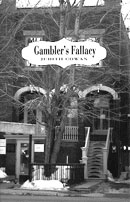
Gambler’s Fallacy
Judith Cowan
The Porcupine’s Quill
$19.95
paper
200pp
0-88984-225-6
Gambler’s Fallacy is a series of seven linked stories set in the “strange secretive little city” of Trois-Rivières and its environs. These mainly dark stories loosely follow the cycle of the seasons from March through the following February; the circumscribed life in the community is emphasized when characters who are highlighted in some stories occasionally reappear in the background of others. Some common local reference points – the Café Zénob, the statue of Maurice Duplessis, the paper mill, the port – imply various levels of significance, as do frequent references to the changing weather.
Cowan’s fiction expresses an abiding sympathy for individual humans in their elemental loneliness and isolation, for people struggling on with hope in the face of defeat. Typical is Raymonde, of the long opening story “The Launching.” In her forties, she is the current mistress of the minor self-important poet Russell Paradis. Surviving past disappointments, she “held her head up, took her vitamins, dyed her hair, and looked resolutely forward.” But her self-sacrificing loyalty to Paradis is finally rewarded with public humiliation and her fuller recognition of his insensitive and coldly exploitative nature.
Human and social concerns are expressed in “Lucifer, Beelzebub and Satan,” a harrowing and over-lengthy account of an intelligent and educated man’s descent into madness and dereliction. The full horror of Simon’s condition is achieved not so much by a careful selection of detail as by an unrelenting bludgeoning of the reader with an exposition of Simon’s suffering and thought processes as the voices of his demons, his only friends, whisper or shout in his ears.
In general the most successful of Cowan’s stories in terms of control and structure are also the shortest. The clarity and orderliness of the writing in “The Best Time of the Night” admirably serve to reflect the nature of the central character and to explore his dilemma. Jacques is hurt and puzzled by the loss of his wife and daughters to the bright lights of Montreal and Europe. At fifty, at last feeling rooted and unwilling to leave Trois-Rivières, he resents that his former contentment has been ruined by the ambition and aggressiveness of modern women. While conventional, the story contains no epiphany. After pondering his situation until dawn, Jacques goes to bed wishing, with rather heavy significance, to “keep out as much light as possible.” The essentially sympathetic portrait of Jacques has a satisfying psychological depth which makes his inability to adjust both poignant and inevitable.
The book’s prevailing sombreness of tone is sometimes relieved by flashes of satire – the account of what passes for the artistic and intellectual community in a provincial backwater; the dedication of a “metal monstrosity” as “a memorial to poets…whose writings have been in vain” – but there are precious few moments of levity or humour. However, the final story in the collection ends with an exquisitely Canadian passage which is both comic and central to Cowan’s artistic concerns: a troubled man alone on a winter night hears the unmistakeable sound of another man chipping ice from a car. “Someone else just trying to get home. Clearly, through the ice-cold blackness came the small persistent sound of hopeful human purpose.”
The short story is a demanding form, and Cowan does not yet seem to have the confidence needed to trust her writing or the reader. Too often her omniscient narrators tell rather than show, explain and underline rather than imply. But whatever the occasional weaknesses in presentation, there is a feeling of artistic integrity in these stories which convinces the reader of the authenticity of the lives portrayed. mRb






0 Comments